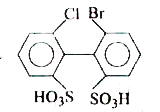Which of the following will show optical activity?




The correct Answer is:D
To determine which of the given compounds shows optical activity, we need to identify if they contain chiral centers. A chiral center is typically a carbon atom that has four different substituents attached to it. Here’s a step-by-step solution:
Step 1: Understand the Criteria for Optical Activity
- A compound is optically active if it has at least one chiral carbon atom.
- A chiral carbon must have four different substituents (or groups) attached to it.
- If a compound has symmetry or can be superimposed on its mirror image, it is not optically active.
Step 2: Analyze Each Option
1. Option 1: Check for chiral centers.
- If the central carbon has two identical groups or shows symmetry, it is not chiral.
- Conclusion: This compound does not show optical activity.
2. Option 2: Check for chiral centers.
- If this compound also has symmetry or a carbon with two identical groups, it is not chiral.
- Conclusion: This compound does not show optical activity.
3. Option 3: Check for chiral centers.
- Similar to the previous options, if there is symmetry or identical groups, it is not chiral.
- Conclusion: This compound does not show optical activity.
4. Option 4: Check for chiral centers.
- Identify the carbon atoms and their substituents.
- If one carbon has four different groups (e.g., bromine, hydrogen, CH2, and another carbon), it is chiral.
- Conclusion: This compound shows optical activity.
Final Answer
- The compound that shows optical activity is Option 4.
- A compound is optically active if it has at least one chiral carbon atom.
- A chiral carbon must have four different substituents (or groups) attached to it.
- If a compound has symmetry or can be superimposed on its mirror image, it is not optically active.
1. Option 1: Check for chiral centers.
- If the central carbon has two identical groups or shows symmetry, it is not chiral.
- Conclusion: This compound does not show optical activity.
- If this compound also has symmetry or a carbon with two identical groups, it is not chiral.
- Conclusion: This compound does not show optical activity.
- Similar to the previous options, if there is symmetry or identical groups, it is not chiral.
- Conclusion: This compound does not show optical activity.
- Identify the carbon atoms and their substituents.
- If one carbon has four different groups (e.g., bromine, hydrogen, CH2, and another carbon), it is chiral.
- Conclusion: This compound shows optical activity.
- The compound that shows optical activity is Option 4.
Similar Questions
Knowledge Check
- Question 1 - Select One or More
Which of the following will show optical isomerism?
A B
B C
C D
D
Which of the following will show optical isomerism? .
View SolutionWhich of the following is not optically active?
View SolutionWhich of the following is not optically active?
View SolutionWhich of the following does not show optical activity ?
View SolutionWhich of the following is optically active?
View SolutionWhich of the following is optically active
View SolutionWhich of the following is/are optically active?
View Solution

